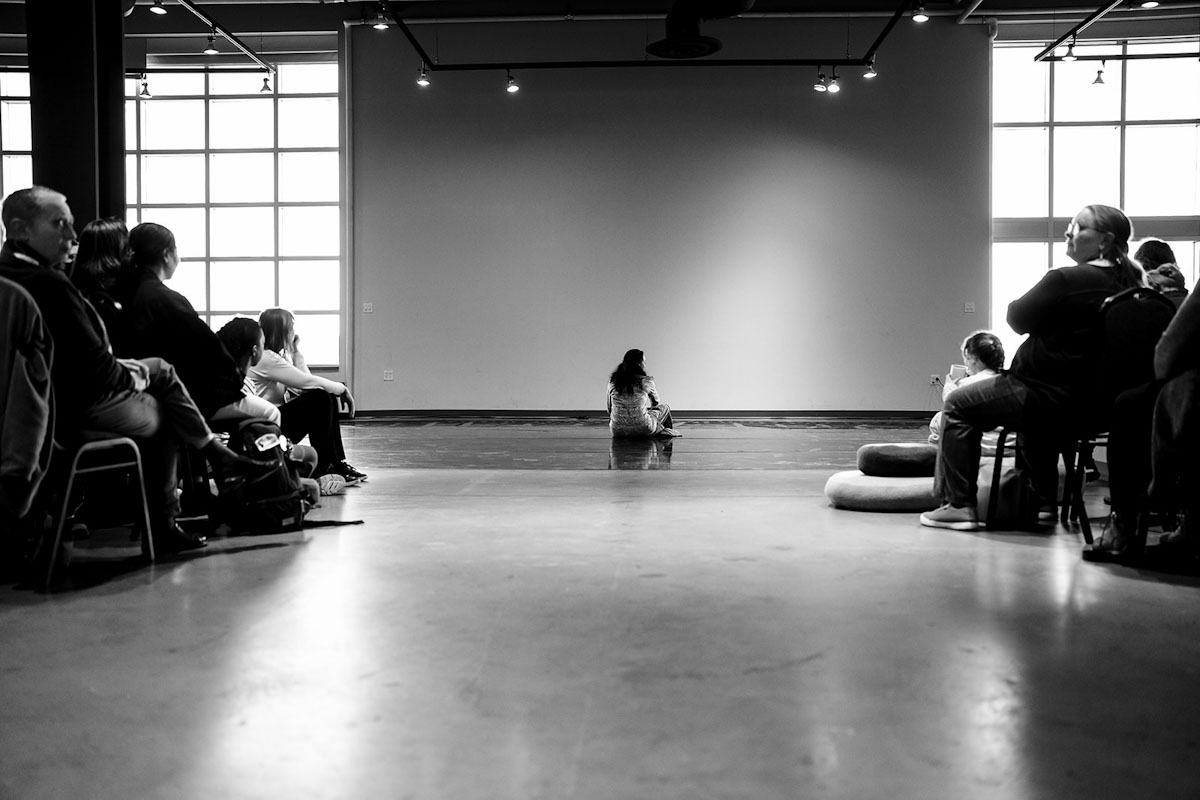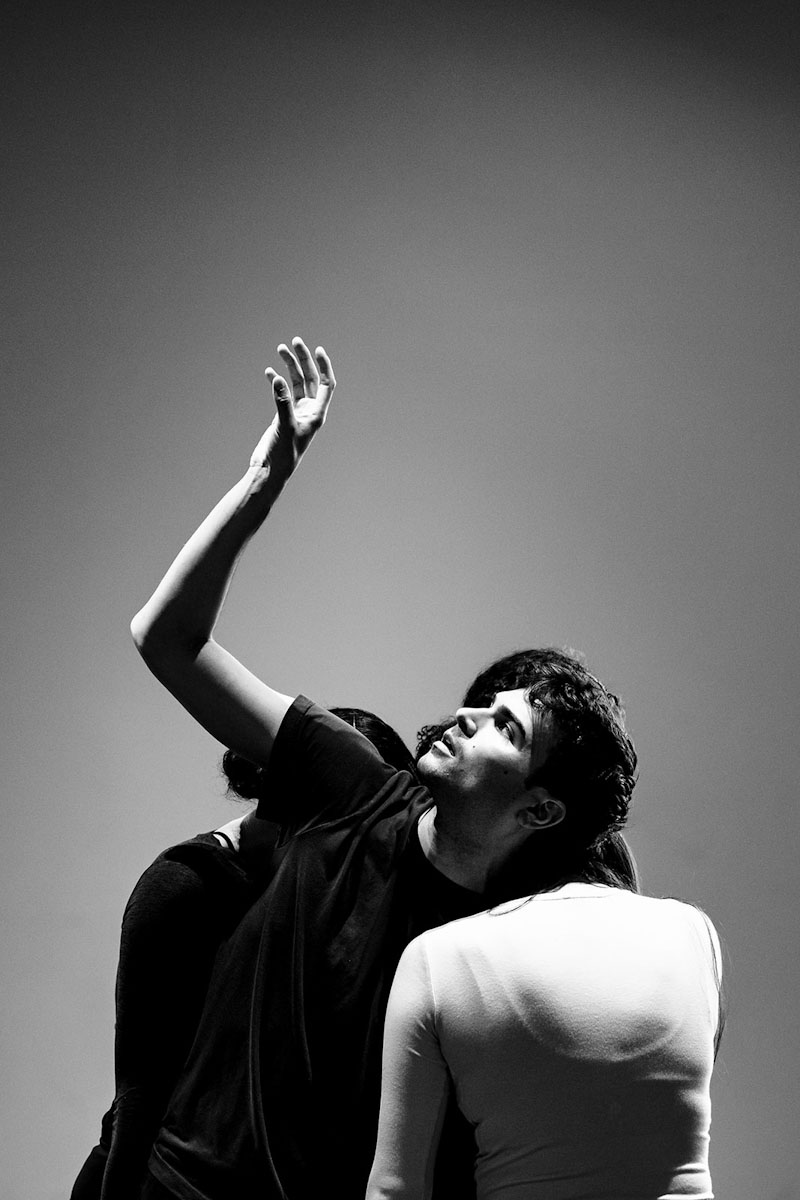
shalan joudry (pictured onstage) is the author of the the poem Kmɨtkinu, which was adapted into a dance piece with collabotors Sarah Prosper, Susanne Chui, Sara Coffin, Isaac Abriel, Robert Azevedo, I'thandi Munro, Sam Penner and NAT Chantel. Photo by Kevin MacCormack
“We are not the only ones looking to heal.”
Museum artist-in-residence shalan joudry is a multi-disciplinary Mi’kmaw artist. Her work in progress was presented at the Museum April 19, 2024.
Our readers might wonder if we’ve made a mistake by not capitalizing your name. Why do you write your name and the subjective pronoun “i” in lowercase?
Not capitalizing my name started when i was 16 and reading poetry from writers around the world. I noticed that some writers didn't have to capitalize their name. It started me thinking about the grammar rules we have in English and when people are allowed to ignore them. I wondered, in our Mi'kmaw language, which is an oral language, how will we decide grammar rules and what capitalizing really means. I decided that keeping it all lowercase looked like it flowed, like there was no word more important than the rest. Like the sharing circles we have in our culture, which i was learning about by attending the Wolastoqey/Mi'kmaw cultural camp as a youth. Keeping my name and "i" lowered reminds me that i am not more important than others.
tensions are mounting
while the sun sets
we find ourselves at the edge
let us not forget one another in the coming cold
i will hold flame while you pray for health
and you can hold flame for me
then let us place both in a hearth
made of grandparent rocks from the land we’re on
-excerpt from Kmɨtkinu, by shalan joudry
Kmɨtkinu means our homeland in Mi’kmaw. What is the poem about?
The poem follows the colours of day, around the seasons, around a sharing circle, the time it takes to reflect, then mourn, then awaken each other, care for each other. It describes an abstract sharing circle i imagine myself within, among family, community, and all people here. I write it this way because i believe in the power of healing and i believe in peaceful futures.
When did you write it?
After the Truth and Reconciliation of Canada Report came out in 2017, i was getting more phone calls and emails - people wanting to talk with me about what they were learning -and it sparked this thought: i wanted to reflect on the long history that Mi'kmaq have in this very landscape, how the years/generations of colonization were short by comparison. In agreement with others, i felt that all people, including immigrants, should be learning about the various difficult truths here. My intention was to then have it translated into various other languages, to represent how i wanted to be heard and understood by various peoples.
You also reworked the poem into a podcast soundscape collage. What is your interest in reworking the material in different ways?
Everytime i talk about the intent of the poem, it reminds me that there are other ways to connect to people to share my feelings about "homeland.” We can sing it, dance it, and sit in circle about it. When i first wanted to write it, i knew i wanted it in various languages, but then i wanted each of the translators to read it in their own voices. Once i thought of that, i really wanted to have parts of their readings woven with mine. And when you get voices together i always think of singing, and the power of music. After the podcast was created, i was talking with Susanne Chui of Mocean Dance (her aunt was one of the translators). She and i were saying that we can imagine that whole poem as a dance piece. I love seeing how we can reach people using diverse mediums, and expand the conversation.
“Learning about the truth of Canada's colonial past isn't just for people who have been making Canada their home for generations, it's also for newcomers to learn and be part of the healing together.”
The dance piece doesn’t contain any text. How do you turn text into movement?
Creating a dance piece based on this poem was really the work and talent of my collaborators: Sarah Prosper, Susanne Chui and Sara Coffin, and then with the dance artists involved: Isaac Abriel, Robert Azevedo, I'thandi Munro, Sam Penner, and NAT Chantel. We began in 2023 with the core collaborators working in the museum and virtually to discuss the intentions of the poem, exploring movements, choreography methodologies and allowing time for ruminating. In April, we spent the first week grounding to physical land, being in ceremony, in circle, reading the poem and then spending time discussing history. The choreographers and dancers worked with the text as inspiration while they moved together for another two weeks.

Photo by Kevin MacCormack.
This project involves a lot of translation: translation into different languages, and translation of language into movement. Is translation a theme you work with consciously?
I have always been curious about the separation of people and the ways that we miscommunicate or don't understand each other, how we think and work differently. And so, the ways that we can translate to communicate different ideas is a powerful concept. In this way, it isn't about the translation as much as it's about "how can i create this message in other ways to make it accessible to different people?" My message about this landscape, the history and my hope for the future, is what carries me into the next iterations.
Why did the Museum’s residency program make sense as a place to develop the piece?
Learning about the truth of Canada's colonial past isn't just for people who have been making Canada their home for generations, it's also for newcomers to learn and be part of the healing together. This was really evident to me as i worked with the various translators. I am aware that most cultures and families have a "homeland" to have feelings about. Many other countries have stories about a type of colonization, or struggle over homeland, as well. We are not the only ones looking to heal. All i can speak to right now is the work here in our homeland. I want to put my hands, mind and heart to this work of helping our L'nu culture thrive, and also be part of the healthy future for all people living here in Mi'kma'ki, which includes newcomers. I was drawn to the idea of the museum's residency because not only did it help inspire the reach to newcomers, but it made me think about who is standing here at the pier saying, "Hello, welcome to Mi'kma'ki".
Are there future plans for the project?
We want to continue to work on the dance piece over the next year. The full written poem in all 13 languages is being published as a hand-pressed book through Running the Goat Books and Broadsides later this year.
shalan's books of poetry can be ordered through Gaspereau Press.